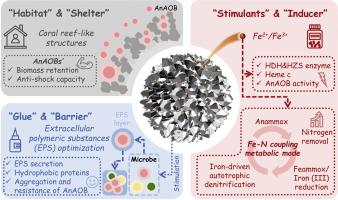当前位置:
X-MOL 学术
›
Water Res.
›
论文详情
Our official English website, www.x-mol.net, welcomes your
feedback! (Note: you will need to create a separate account there.)
Metal-organic framework material-derived Fe-Si micro-nuclei drive a robust anammox process via multiple pathways: “Shelter” provision, “barrier” reinforcement, and biological “inducer” modulation
Water Research ( IF 11.4 ) Pub Date : 2025-05-26 , DOI: 10.1016/j.watres.2025.123906
Pengcheng Wang, Boran Wu, Bin Lu, Xiaoli Chai
Water Research ( IF 11.4 ) Pub Date : 2025-05-26 , DOI: 10.1016/j.watres.2025.123906
Pengcheng Wang, Boran Wu, Bin Lu, Xiaoli Chai

|
Anaerobic ammonium oxidation (anammox) has emerged as a pivotal biotechnology for sustainable nitrogen removal owing to its energy efficiency and low carbon footprint. However, persistent challenges in microbial growth rate, process stability, and nitrate byproduct accumulation constrain its full-scale implementation. This study addresses these limitations through the innovative synthesis of a metal-organic framework (MOF)-derived Fe-Si micro-nucleus (PFMS), engineered to drive a robust anammox system at lower micro-nuclei doses and mitigate potential risks of excessive iron inhibition. Its coral reef-like mosaic structure provides “habitat” and “shelter” for anammox bacteria. Multivalence-Fe in PFMS was identified with X-ray adsorption fine structure spectra and facilitated the growth and nitrogen metabolism of anammox bacteria. Density functional theory calculations provided unprecedented atomic-level insights into substrate-material-microbe interfacial interactions. Meanwhile, PFMS drives the optimization of extracellular polymeric substances for enhancing aggregation and resistance of anammox sludge. Microbial community and metabolic in PFMS-mediated anammox system were investigated by multi-omics analysis, and the results showed that a novel Fe-N coupling metabolic mode was established in the system. Furthermore, the mechanism underlying the enhancement of anammox system by PFMS was summarized. This study constitutes the inaugural application of MOF-derived materials in anammox biotechnology and provides a novel strategy for operating a robust anammox process in practical engineering applications.
中文翻译:

金属有机框架材料衍生的 Fe-Si 微核通过多种途径驱动强大的厌氧氨氧化过程:“庇护所”提供、“屏障”加固和生物“诱导剂”调制
厌氧铵态氮氧化 (anammox) 由于其能源效率和低碳足迹,已成为可持续脱氮的关键生物技术。然而,微生物生长速率、工艺稳定性和硝酸盐副产物积累方面的持续挑战限制了其全面实施。本研究通过创新合成金属有机框架 (MOF) 衍生的 Fe-Si 微核 (PFMS) 来解决这些限制,该 PFMS 旨在以较低的微核剂量驱动强大的厌氧氨氧化系统并降低过度铁抑制的潜在风险。其珊瑚礁状的马赛克结构为厌氧氨氧化细菌提供了“栖息地”和“庇护所”。用 X 射线吸附精细结构光谱鉴定 PFMS 中的多价 Fe 并促进厌氧氨氧化菌的生长和氮代谢。密度泛函理论计算为衬底-材料-微生物界面相互作用提供了前所未有的原子级见解。同时,PFMS 驱动细胞外聚合物物质的优化,以增强厌氧氨氧化污泥的聚集和抵抗力。通过多组学分析研究了 PFMS 介导的厌氧氨氧化系统中的微生物群落和代谢,结果表明在该系统中建立了一种新的 Fe-N 偶联代谢模式。此外,总结了 PFMS 增强厌氧氨氧化系统的潜在机制。这项研究构成了 MOF 衍生材料在厌氧氨氧化生物技术中的首次应用,并为在实际工程应用中运行稳健的厌氧氨氧化工艺提供了一种新策略。
更新日期:2025-05-26
中文翻译:

金属有机框架材料衍生的 Fe-Si 微核通过多种途径驱动强大的厌氧氨氧化过程:“庇护所”提供、“屏障”加固和生物“诱导剂”调制
厌氧铵态氮氧化 (anammox) 由于其能源效率和低碳足迹,已成为可持续脱氮的关键生物技术。然而,微生物生长速率、工艺稳定性和硝酸盐副产物积累方面的持续挑战限制了其全面实施。本研究通过创新合成金属有机框架 (MOF) 衍生的 Fe-Si 微核 (PFMS) 来解决这些限制,该 PFMS 旨在以较低的微核剂量驱动强大的厌氧氨氧化系统并降低过度铁抑制的潜在风险。其珊瑚礁状的马赛克结构为厌氧氨氧化细菌提供了“栖息地”和“庇护所”。用 X 射线吸附精细结构光谱鉴定 PFMS 中的多价 Fe 并促进厌氧氨氧化菌的生长和氮代谢。密度泛函理论计算为衬底-材料-微生物界面相互作用提供了前所未有的原子级见解。同时,PFMS 驱动细胞外聚合物物质的优化,以增强厌氧氨氧化污泥的聚集和抵抗力。通过多组学分析研究了 PFMS 介导的厌氧氨氧化系统中的微生物群落和代谢,结果表明在该系统中建立了一种新的 Fe-N 偶联代谢模式。此外,总结了 PFMS 增强厌氧氨氧化系统的潜在机制。这项研究构成了 MOF 衍生材料在厌氧氨氧化生物技术中的首次应用,并为在实际工程应用中运行稳健的厌氧氨氧化工艺提供了一种新策略。


















































 京公网安备 11010802027423号
京公网安备 11010802027423号